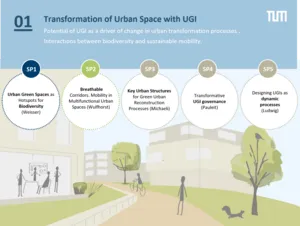Research Cluster 1: Transformation of Urban Space with UGI
Head: Mark Michaeli
The significance of urban environments for biodiversity is now widely recognized and integrative ways to retain and enhance biodiversity within cities are sought. However, many urban residents live in districts where only a few plant and animal species occur, and this makes people increasingly separated from nature in their daily life.
UGI provides opportunities where city dwellers can experience nature, and such experience also determines how humans perceive and value it. Moreover, biodiversity underlies many ESS demanded by humans, including direct effects on well-being and health. Therefore, urban ecological reconstruction to enhance biodiversity is wanted, particularly if it comes along with the rising quality of urban life, synergies with daily activities, and the related potential for sustainable urban mobility, such as walking and cycling.
Unfortunately, urban nature and UGI have been neglected as potential drivers of change in urban planning so far despite ambitious sustainability goals laid down in strategic urban development frameworks, and in the practice of urban transformation, the potential of UGI is far from being sufficiently tapped. This is often explained with lock-in effects caused by the self-stabilizing forces of the existing urban structures and their operational framework.
Thus, sustainability transition relies on socio-technical regime transformation, mirroring all three key dimensions of SET's. A systems analysis of the governance processes is needed to overcome the barriers to integrated planning and implementation of multifunctional UGI. Case-study research has revealed complex combinations of culture-, structure- and practice-led agencies as key success factors of long-term transformation.
Scenario research has explored the plausibility of promoting or prioritizing particular avenues (e.g., political vs. market-driven approach) in facilitating transformation and application of new solutions. We seek to augment systemic knowledge in the field by complementing the multi-disciplinary approach to SET transitions by shedding light on the nature of solutions to implement UGI with the three strategies of operationalization, substitution, and integration. Characteristics of solutions as well as processes of deployment and operation of UGI, including relevant governance modes and actor networks are scrutinized against the backdrop of contemporary practice in urban transformation projects.
The goal of Cluster 1
RC 1 aims to significantly enhance the process of transformation of the existing urban fabric and its elements towards a multifunctional UGI as a valuable resource in terms of biodiversity, sustainable urban mobility and reconstruction. The strategy of green-gray Integration is emphasized by the first two subprojects:
SP1 (Biodiversity) will study the potential of UGI for creating continuous and coherent elements of high value for biodiversity within the urban built fabric. Today, the majority of urban transformation projects focus on the element, not the network scale, thus the possibility for immediate intervention is often limited on large-scale infrastructure projects coming along e.g., with a substantial change of street layout, transportation technology and mobility behavior. Therefore, SP1 is closely interacting with SP2 (Mobility) to enhance the ecological functionality of the smart integration of UGI into the reconstruction of mobility spaces, and reciprocally upgrading these spaces as the spinal network of UGI.
Ensuing questions for UGI Operationalization are in the focus of SP3 (urban reconstruction) and SP4 (Gobernance). SP3 sheds light on the subsequent structural properties of the urban elements and networks and draws links to typical urban renewal and development projects and their qualification potential as catalysts of UGI implementation. It is expected, that this process can be facilitated with better knowledge of transformation regimes, which is systematically examined in SP4.
Finally, SP5 (Designing UGI) complements RC1 with the consideration of dynamic processes in UGI design, with links to SP1 and other research clusters (subprojects 6 (indoor-outdoor), 7 (microclimate) and 8 (Urban trees)). The novelty of the approach lies in the entanglement of structure and process, highlighting urban reconstruction and the transformative potential of UGI. The results of RC1 at different spatial scales will be considered as input for a common systems model.
The subprojects of research cluster 1 are
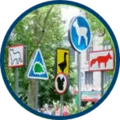
PI: Prof. Dr. Wolfgang Weisser
Affiliated researchers: Prof. Dr. Sebastian T. Meyer, Xia Yao
PhD candidate: Andrew Fairbairn
Dissertation: Designing wildlife-inclusive multifunctional urban green infrastructures.
Background: Densification puts pressure on the remaining natural areas within cities, such that fragments of natural habitat shrink, then disappear, and connections between remnant green spaces are lost. Urban biodiversity can be high, yet it is only in the past years that the factors promoting biodiversity are beginning to be unraveled. While species richness in cities is positively related to the amount and size of urban green space available, the importance of particular elements of UGI for the occurrence of certain species is only beginning to be understood. Approaches are needed that actively create new wildlife habitats and that appreciate the value of built-up areas for urban wildlife. Building on the concept of wildlife-inclusive urban design, we will investigate the potential of UGI to be designed to be multifunctional, for both humans and also animals. Close collaboration will be sought with projects of RC 1, but also with RC2 and RC3, to explore the potential of the different approaches for wildlife-inclusive design. Jointly with SP2, we seek to explore the promotion of sustainable mobility through biodiverse streets and connect this with the effects on public health (SP9), the characterization of old trees (SP8), and the establishment of novel plant systems (SP13).
Objectives: This project will measure the contribution of various elements of UGI to the promotion of animals within cities.
The objectives are to:
(O1) Analyze the role of UGI elements for different animal functional groups;
(O2) Explore the chances of operation, substitution and integration in enhancing animal biodiversity in cities;
(O3) Develop strategies for the multifunctional design of UGI including the promotion of urban wildlife.
The following hypotheses (H) will be tested:
(H1) Bushes, trees, and herbaceous vegetation make different and complementary contributions to provide habitat features for animals, with animal species-specific minimum thresholds for habitat function, measured by the volume and/or the age of the element;
(H2) Biodiverse streets can be designed with significantly increased habitat function compared to current streets, addressing all phases of animal life-cycles and resulting in a significantly enhanced possibility of positive human-animal interactions;
(H3) Design strategies for multifunctional UGI can be developed that include the promotion of urban wildlife without compromising other functions of these UGI
Methods: To analyze the role of UGI elements for the diversity of bat, birds, and insects, we will employ sampling methods such as bat (Ecoobs) and sound (Frontier Lab) recorders as well as window traps or sweet-netting. Individuals will be analyzed to species level by a combination of automatic species identification, expert identification and barcoding of samples. In a stratified design, we concentrate sampling on those urban structures that are the subject of other subprojects, with different degree of greenness and plant species composition. We will use the software RangeShifter to model the persistence of animal populations in a city based on the implementation of different types of UGI.
Outlook: In Period II, experimental UGI elements will be created to test the feasibility of the approaches.
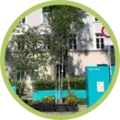
PI: Prof. Dr.-Ing Gebhard Wulfhorst
Affiliated researchers: Sindi Haxhija
PhD candidate: Mahtab BaghaiePoor
Dissertation: Understanding the interactions of urban green infrastructure and active mobility.
Background: More than 50% of local trips can be realized by active mobility, while pedestrians and cyclists are specifically sensitive to the quality of the urban environment. Therefore, it is expected that UGI can enhance the quality of recreational destinations at a short distance, increase walkability within neighborhoods, improve cycling conditions along green corridors, and thus contribute to an enhanced quality of urban life. However, in accessibility research, there is still a lack of considering comfort in the criteria for the service of active mobility. Walking and cycling comfort is influenced by diverse factors, such as visual and aural stimuli, micro-climate and air quality, which are strongly related to the presence and quality of UGI. As the presence of UGI correlates with the mode share of active mobility, further investigations are necessary to understand these interactions and to achieve more sustainable mobility patterns. At the same time, the transport network structure can contribute significantly to the integration of UGI into urban environments. Synergies of climate change mitigation (a high share of active modes) and adaptation (preventing heat islands) in urban environments are crucial.
The objectives of this SP are to:
(O1) Review the potential of multifunctional UGI as ‘breathable corridors’ enhancing the attractiveness of ‘soft modes’;
(O2) Analyze the relationships of UGI features and performance (network structure, biodiversity, pollutant reduction, cooling effect, etc.) concerning the impacts on walking and cycling comfort and the overall human well-being in urban areas;
(O3) Examine the spatial and governance requirements for the creation of ‘breathable corridors’.
Main research questions (Q) are:
(Q1) Which effect does UGI have on pedestrians and cyclists (mode choice, route choice)? How does this change depend on daytime and season (concerning illumination and weather conditions)?
(Q2) Which direct impact, both positive and negative, do specific characteristics of UGI have on human comfort and well-being?
(Q3) What are the requirements and potentials in mobility governance for creating added value of active mobility networks with respect to the development of UGI for attractive urban spaces and which conclusions can be drawn for its further enhancement?
Methods: Empirical research will be undertaken in stage 1 by user surveys, revealing the preferences of environmental factors on mobility behavior (depending on trip purpose, age, gender, etc.) to derive the requirements on the quality of the surrounding UGI (SP1). By linking the survey results with measurements of e.g., thermal comfort (SP7) and air quality, correlations between UGI effects and user perceptions can be quantified in stage 2. Moreover, expert interviews will help to identify the specific user needs to be included in planning processes. To generate transferable results, contributions towards a system model will link up the specific research question to the UGI framework. The findings will help urban planners to develop suitable green (blue) urban network structures that promote active mobility under the inclusion of all user groups, and at the same time enhance biodiversity and stormwater management. Related governance questions will be addressed in stage 3 by policy study and in different workshop formats, such as design workshops and to foster stakeholder cooperation in urban-transport planning processes.
Outlook: In Period II, synergies between the network structure of urban streets and the connectivity of UGI will be investigated on the level of urban neighborhoods.
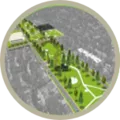
PI: Prof. Dipl. Arch ETH Mark Michaeli
PhD Candidate: Ishika Alim & Julia Micklewright
Dissertation: Key Urban Structures for Green Urban Reconstruction Processes.
Background: Many measures taken over the past decade have concentrated on enhancing urban sustainability at the level of built elements (building, building elements and materials, planning regulations on plot scale). However, the syntactical spatio-structural properties of the City as Living System still is poorly understood. It is expected that carrying capacity and ecological performance of UGI is highly dependent on the spatial and temporal coherence and continuity of new gray-green infrastructure networks (SP1). Therefore, it is crucial to develop transformation projects which help to establish or enhance these superordinate network structures to enhance performance characteristics of the UGI and raise awareness in society towards environmental aspects embedded in ongoing transformation processes
In a short-term perspective future mobility trends which in the city come along with megatrends like digitization and new forms of housing and work are of particular interest, since they might unfold powerful potential for urban reconstruction which can explicitly be activated for implementation of UGI (SP2). Reciprocally, it is expected that the presence of UGI will have a substantial impact on the use patterns/routines of the city and subsequently catalyze further reconstruction processes and promote new set-ups for urban projects (location, mix, contextual conditions) which need to be mirrored sufficiently in ongoing qualification processes of the networks to assure future connectivity, adaptability, and resilience.
The objectives of this SP are to:
(O1): Analyze the potential for cross-fertilization between urban redevelopment projects with concepts for sustainable mobility on the one hand, and UGI qualification, on the other;
(O2) Increase the reciprocal compatibility of UGI projects and urban renewal by emphasizing the continuity aspects in planning of urban configuration (elemental and urban tissue scale);
(O3) Evaluate the generalizability and transferability of success factors into other urban project contexts or set-ups.
Main research questions are:
(Q1) What are potentialities and risks in UGI-projects if coupled, synchronized or phased with renewal projects and maintenance operations in urban infrastructure?
(Q2) What are urban patterns and layouts allowing for easier integration with UGI?
(Q3) In which way are the change of lifestyles as well as the technological advancements drivers of change to facilitate the subsequent change of urban structure?
(Q4) What role play amended planning frameworks and toolboxes for speeding-up implementation processes of UGI? (jointly with SP4)
Methods: Research on ‘carrier’ conditions for UGI-implementation through projects in infrastructural renewal is carried out by literature review (theme-oriented) and case study (context-oriented) approach. The findings feed into a model of (inter-)dependencies (stage 1). In stage 2, the model will be consolidated through expert interviews and workshops where the plausibility of modeled solutions for /paths to UGI potential is discussed in application, through simulation in the scenario approach based on the cases of stage 1. Solutions derived from this then will be examined with regard to connectivity in legal and economic contexts of urban projects in stage 3. This allows for integration into testbed of the Urban Labs, and into model projects tying into the cross-sectoral approach of SP2 and SP4.
Outlook: SP3 in Period I is limited to reconstruction processes of urban mobility as driver of change, other trend-based processes will be evaluated in Period II with regard to their capacity to be the carrier for accelerated UGI implementation in the urban realm.
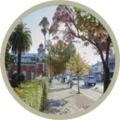
PI: Prof. Dr.-Ing. Stephan Pauleit
Affiliated researchers: Martina van Lierop, Eleanor Chapman
PhD Candidate: Elizaveta Weber-Fakirova
Dissertation: Shifting governance regimes for the scaling of Urban Green Infrastructure.
Background: Enhanced governance regimes are required for the development and scaling of multifunctional UGI to overcome the bottlenecks of sector-based decision making and mobilize the array of different stakeholders. For this, the role of and interactions among different modes of governance such as top-down planning, partnerships between the public and the private sector, social entrepreneurship, and community-driven governance need to be better understood in a multilevel governance framework and aligned in what has been called the ‘mosaic governance’ of UGI. Building on recent research, this subproject will explore ways of improving current governance regimes to create momentum for urban transformation via UGI. Cooperation will be particularly close with SP3 and SP5.
This subproject aims to systematically explore the potentials to transform current and alternative modes of UGI governance on different planning levels.
Its objectives are to:
(O1) Assess the capacity of current UGI governance to develop and scale multifunctional UGI;
(O2) Probe the potential of alternative modes of governance for urban transformation via UGI;
(O3) Identify the momentum for a shift towards transformative governance for UGI in a multilevel approach.
The main research questions (Q) are:
(Q1) What is the current governance regime for UGI with its relevant actor networks, and what are the potentials and barriers for their vertical and horizontal cooperation?
(Q2) What are necessary governance changes (policy, management, incentives) to enhance the capacity for the implementation of transformative UGI? What are effective supporting tools such as new forms of cooperation, planning instruments, regulations, and financing?
(Q3) Which ‘windows of opportunities’ and interventions in governance, structures, and practice can support transformative governance of UGI, and how can this shift be sustained?
Methods:
The project will combine an in-depth case study (Munich) with qualitative and foresight methods. In stage 1 of the doctoral thesis, the current UGI governance regime will be assessed by mapping UGI initiatives, their related stakeholders, and the current governance modes of operation to identify clusters of collaboration that work on specific UGI, scrutinize which urban challenges are addressed by these clusters, and how they relate to the UGI solutions developed in the three clusters. The potentials and barriers for multilevel cooperation between stakeholders will receive particular attention. Through a literature review, the results from the case study will be placed into the wider context of governance research. Findings will serve as an input into stage 2, in which doctoral candidates together with stakeholders define which new collaborations or governance structures can support changes in UGI governance regimes. The transformative potential of these changes in the governance regime in urban spaces of selected urban labs will be explored in the scenario approach. In stage 3, specific windows of opportunity and the potential of selected tools to introduce new modes of UGI governance will be investigated in workshops and interviews with stakeholders and experts.
Outlook:
In Period II, it is envisaged that SP4 will engage in a reflective inquiry of interactions between UGI as a technology with society, e.g., to address issues of environmental injustice, by introducing a new PI from the TUM School of Governance or the Munich Center for Technology in Society.

Head: Prof. Dr. Ferdinand Ludwig
Affiliated researcher: Xiaohan Zhang
PhD Candidate: Hadi Yazdi
Dissertation: A workflow to design UGI as dynamic open systems, demonstrated by the integration of tree growth in architectural development and urban transformation.
Background: The capacity of UGI to support human health and well-being by providing ESS relies on the long-term development of plants and corresponding design and management methods. However, UGI is usually designed with the focus on an aspired final state and the development process up to the achievement of this goal is not adequately considered. Neglecting the processual aspects of UGI can lead to failures concerning the provision of ESS and to overlooking potential synergies between UGI development and urban transformations (SP3). So far only few projects feature, e.g., tree growth as a key aspect of the design concept and relate it to urban transformation. In contrast, in this project design is understood as open systems design, focusing as much on the management of growth processes as on the initial planting design. By adding the aspect of time to the evaluation of key performance indicators the project will contribute to the indicator framework and willprovide all projects with a methodological basis for transferring the scientific findings into design practice (operationalization). The specific focus of the project will be on urban trees and their integration in the built environment as hybrid systems.
The overall objective is to develop a workflow to design UGI as open dynamic systems with only partly predictable developmental pathways.
The main objectives are:
(O1) Development of an iterative design process that integrates the established methods of tree growth modeling (SP8) and microclimate modeling (SP7);
(O2) A Voxel model to describe target parameters in space and time within this design process;
(O3) Visualization methods that adequately represent and communicate the results of this design process, with particular attention to aspects of uncertainty.
The research questions are:
(Q1) How can the dependency between partially unpredictable growth processes and intended effects of UGI be taken into account in design?
(Q2) How can the intended effects of UGI be described as spatial and time-dependent parameters?
(Q3) How can the iterative design process (O1) and the voxel model (O2) be used to design UGI as dynamic, open systems and how can such designs be represented?
Methods: To capture the necessary plant structure for growth and microclimatic modeling we will build on the findings of urban trees characterization (SP8) and complement these with novel approaches to data acquisition and extraction, i.e., unmanned aerial vehicles (UAV) survey according to and LiDAR-with-SLAM process according to in stage 1 of the project. For decision support in the iterative design process we will adapt Markov decision processes (MDPs) from forestry science. In stage 2 we will build on methods under development that translate the established representation of data in voxel models into a design approach. The voxel space covers the above as well as the below-ground growth space of trees, thereby connecting to the findings of the research on soil carbon sequestration (SP11). Finally, in stage 3 a research-by-design approach following the work flow established by is employed for visualization. The case studies for this design research will be the breathable corridors from SP2, and the building typologies of SP6 (thereby contributing to the aspect of substitution). Building on the methods established in SP1 and SP6 the results of this test design will be evaluated in regard to urban microclimate, human well-being and biodiversity.
Outlook: For Period II it is planned to up-scale the voxel approach from the building or street level to a neighborhood or city quarter level, and to explore synergies between urban transformation and plant growth concerning social-technological development.
